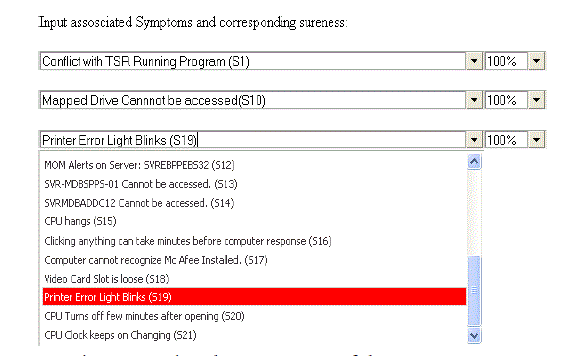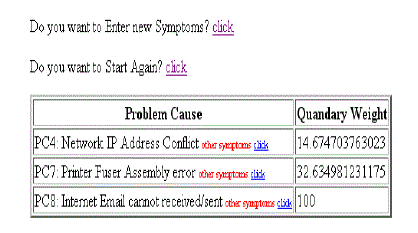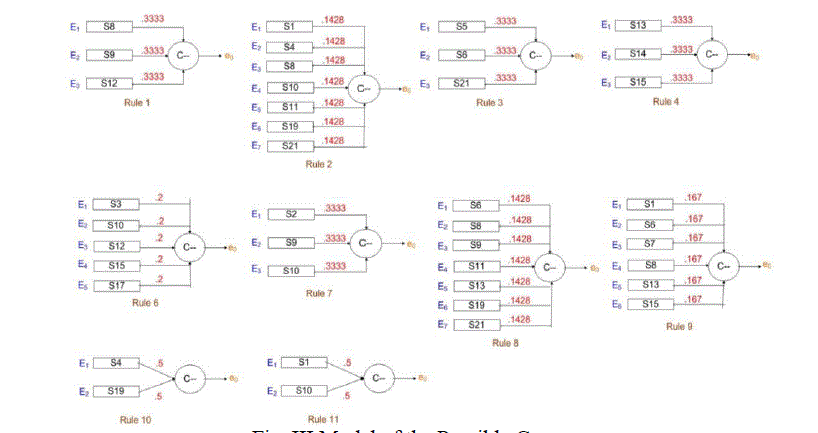Keywords
|
| Conflict Resolution, Data Management, Expert Systems, Information Systems. |
INTRODUCTION
|
| Artificial intelligence is maybe the most important technical contributor in the future [1]. Systems that can make jobs or processes faster are advantageous. |
| An example of an Artificial Based System is an Expert System. This type of system simulates the judgment and behaviour of a human or an organization that has expert knowledge and experience in a particular field or intends to embody the ability and knowledge of an expert in a specific domain [2]. |
| In this era of fast growing Technology and Communication systems, it is very important for corporations and industries to develop Support Division environment technologies to facilitate and diagnose its own Information System Communication Network. The integration of a Helpdesk Contact Center in the organizations structure is of vital importance to a large corporation. Employees of the company are the customers of the division. They facilitate the technical concerns of the employees and diagnose them at the soonest possible time to minimize the delay in operations. |
| For this research Information System Communication Networks refers to the internal technical backbone of an organization solving problems that relate to Information and Communications Technology (ICT), computers and their networking, hardware, firmware, and software applications. The Conflict Resolution Model that was developed will be applied in an Information System Communications Network division of a telecommunications company. |
EXAMPLE OF DEVELOPED EXPERT SYSTEMS
|
| One of the earliest developed Expert Systems which were developed in the early 1970 at Stanford University was the MYCIN [3]. It was the Doctoral Dissertation of Dr. Edward Shortliffe and was written in LISP. This Expert System was programmed to identify the bacteria that can cause severe infections and to recommend antibiotics. This expert system uses an Interference Engine that is composed of six hundred rules. The system will query the physician running the program with a long series of text questions. The result will be a list of possible bacteria that is responsible for the disease. The system will also give a recommended method of treatment. A research conducted by Stanford Medical School found that MYCIN gives a correct diagnosis percentage of 65% which was beneficial to most physicians who are not specialists in that field. This Expert System was never used in practice not because of its weakness in performance but due to its ethical and legal issues on the use of Expert Systems in Medical Diagnosis. |
| Another example of developed Expert Systems is the Caduceus [4]. It was an Expert System developed by Harry Pople in the University of Pittsburg. It started in the early 1970’s. It took a long time to finish and was based on his interviews with Dr. Jack Meyers, one of the top internal medicine diagnosticians. Their intent was to improve the MYCIN Expert System. Instead of focusing on internal medicine, this Expert System can possibly diagnose 1000 diseases. |
| Another Expert System that was created is the MEXSES [5]. This program is a prototype for environmental screening. This software draws a number of Environmental Impact Assessment Techniques in an attempt to combine the most appropriate elements into one intelligent, comprehensive and knowledge-driven. This Expert System manages a database of project assessments and a geographical database of maps and geo-referenced data. This system provides potential environmental impacts in an early stage. The Expert System draws on broad knowledge and databases on project characteristics based on a hierarchical classification scheme and generic profiles. The system’s knowledge base is limited to a few examples of checklists and rules for one problem class. |
| An additional example of a developed Expert System is IMPACT. It is an Expert System used for environmental analysis screening tool that was developed by the US Department of Energy [6]. This software uses a simplified approach to assess the different kinds of impacts like proximity effects, groundwater effects and water pollution. The software gives its results by giving a tabular written report. |
| By year 2001, NASA’s Artificial Intelligence Group Information Systems Technology Section created the Spacecraft Health Inference Engine (SHINE). This system was designed to operate in a non-simulated environment and to be utilized using C and C++ programming languages [7]. Its knowledge base systems include automatic task planning, diagnosis and other applications which require different software modules based on artificial intelligence concepts and advanced programming techniques. This knowledge base can also be customized to meet the user’s own problemsolving representations and techniques. |
| A publicly available Expert System was developed in 2006 by the Expert Health Data Programming called the STD Wizard [8]. It is used for determining which vaccinations, screening tests and evaluations are recommended which are related to sexually transmitted diseases. The information included in this Expert System is based on the Centers for Disease Control and Prevention “Sexually Transmitted Diseases Treatment Guidelines – 2006”. This Expert System is web-based and asks a series of questions to the user. There could be 100 questions but the Expert System usually asks about 20. |
| A challenge in these Expert Systems is Conflict Resolution. If two or more rules in the Interference engine gave a high output, which one will you fire. Few techniques were attempted to solve this problem [9]. One of them was the Means End Analysis (MEA). It was first introduced in General Problem Solver [10]. This search process over the problem space aims to combine aspects both forward and backward reasoning. This approach focused problem-solving on the actual differences between the current state and that goal or calculate the difference between each available option and the goal state. A disadvantage of this is if used in an Expert System is the definition of a goal state. The rules were that goal state that was defined will be fired without consideration to the unfired rules which still have a chance to be the Possible Cause (PC). This paper will present a new Conflict Resolution Model for Expert Systems. It will be applied in Information System Communication Networks. |
CONFLICT RESOLUTION MODEL
|
| The Logic Scoring of Preference (LSP) model is basically used for evaluating complex hardware and software systems like websites. This model was re-engineered by the author to be used as a Conflict Resolution model. This is the first time that it was used in an Expert System. It was used to give a weight to the ones an Expert System has suggested to what the most probable cause. |
| This model was used on the rules an Expert System. The algorithm on how to incorporate it from website ranking to Quandary weighting for expert systems was originally developed by the author Different input parameters may give different probable causes of problems. As in real applications, given different symptoms, a human expert may have different suggestions to a problem and give percent sureness to might have caused the problem [11]. The Conflict Resolution Model algorithm will give the weight. This algorithm can be used in formulating the relationships of the symptoms of the problems, in which symptoms have sub symptoms with different credence relationships. |
| The degree of simultaneity r is represented by this equation |
 |
| An example is when the operation is an Arithmetic Mean, the value of d is 1 and the value of r will be 0.5. |
| The strength of the model over merely additives resides in the power to deal with different logical relationships and operators to reflect the evaluation needs [12]. This strength is advantageous to the Expert Systems which have a Problem and Symptoms relationship. The final products of these systems are Problems with different types of symptoms wherein these symptoms are related with each other. Depending on the number of symptoms, the parameters used for the quandary weight are being selected in the relationship table in the database. |
The Algorithm of the Conflict Resolution Model is as follows
|
| 1) Obtain the percent sureness inputted by the user. |
| 2) Match the corresponding percent sureness to its equivalent Symptom. |
| 3) Initialize the value of the initializing variable A as the feature of the Elementary Preference Ei. Let L be the function for evaluating the Elementary Preference Ei. |
| 4) Determine the number of features in the aggregation block as N. Its value is the number of Conditions necessary to satisfy the Symptoms. |
| 5) Obtain W which is the weight of the specific feature by dividing 100 to the number of features in the aggregation block N. |
| 6) Determine the value of degree of simultaneity r by matching its andor functions to L. |
| 7) Substitute the values to e0 = (W1E1 r+…WkEk r) 1/r the result of the equation will be the weight for the Possible Cause. |
| 8) Repeat for all the Possible Causes that satisfies the Symptoms. |
DATA AND RESULTS
|
| A. Rules of the Expert System from the algorithm |
| The Algorithm and the Conflict Resolution Model will be tested and validated using actual Data. The Data are the problems encountered by a Network Support Division or Information System Communication Networks of a telecommunications company. For Confidentiality purposes, the actual name of the company will not be disclosed. |
| Tables 2, 3, 4 and 5 shows the Table of Symptoms, Table of Possible Causes, List of Symptoms and Possible Causes and the rules of the Expert System respectively. |
| B. Application of the Conflict Resolution Model |
| The Conflict Resolution Model is applied in the rules in Table 5. There are instances when symptoms are inputted, different set of Possible Causes will appear. Example when we input S1, S10 and S19. A percent sureness of 100% was inputted for all the symptoms as shown in Figure 1. |
| Figure 1 shows the user interface to input the symptoms of the Expert System. It has an autocomplete feature to input the symptoms and a select feature for the percentage sureness. |
| The Possible Cause 4, 7 and 8 will be suggested by the Expert System as shown in Figure 2. Take note that based on the Conflict Resolution model the PC with rules that have the most number of values to the once inputted will have the higher Quandary Weight; therefore based on the data that is most likely the Possible Cause. |
| Figure 3 shows the model for the Possible Causes for Table 5. These symptoms have a weak relationship that is why an andor of C-- is defined. Take note that Rule 5 has only one condition. In order to use the Conflict Resolution model there should be at least two or more conditions. |
ANALYSIS AND CONCLUSION
|
| Conflict Resolution is important in Expert Systems. The System may suggest different outputs for a set of symptoms. Without Conflict Resolution, the user will have a hard time in its diagnostic activities and may still result in trial and error. This paper solved that predicament by creating a novel Conflict Resolution Model. This Model is used in Information System Communications Networks. |
| The Conflict Resolution model is used in actual data. It gave quandary weights to the output suggested by the Expert System. The highest weight was outputted by the most likely cause of the Problem based on the Information System. This research created a new Conflict resolution model for Expert Systems by completely re-engineering the LSP that previously can only be used in websites. |
| |
Tables at a glance
|
 |
 |
 |
 |
 |
| Table 1 |
Table 2 |
Table 3 |
Table 4 |
Table 5 |
|
| |
Figures at a glance
|
 |
 |
 |
| Figure 1 |
Figure 2 |
Figure 3 |
|
| |
References
|
- Zhou F., Yang B., Li L., and Chen Z., “Overview of the new typesofIntellegent Support Systems”, Proceedings of the 2008 3rd InternationalConference on Innovative Computing Information and Control, pp. 1-10, 2004.
- Shalaan K., El Badry M., and A. Rafea, “A multiagent approach for diagnostic Expert Systems via Internet ”, Expert Systems withApplications, Vol 24, No. 1, pp. 61-65, 1995.
- Shortlife E., “MYCIN: A rule based computer program for advising physicians regarding antimicrobial theraphy selections”, ProquestStanford University, 1975.
- Pople H., “Artificial Intellegence: Problems and Issues”, CAIA, pp. 1-5, 1985.
- Fedra K., “A computer based approcach to environmental impact assesment”, Proceedings of the Workshop in Indicators and Indices forEnvironmental Impact Assessmentand Risk Analysis, pp. 11-40, 1991.
- Geraghty P., “Environmental assestment and applications of Expert Systems”, Environmental Management, pp. 61-65, 1993
- Jet M., and James M., “An Autonomous Diagnostic and Prognostic Monitoring System for NASA’s Deep Space Network”, IEEE Aerospace,2001.
- Expert Health Data Programming, [online], 2006, EHDP, Website: http://www.stdwizard.org/ (Accessed: July 20, 2013).
- Avelino M., and Torre F., “Advanced Rule-Based Techniques in Mission Critical Systems”, Second International Conference on EmergingSecurity Information Systems and Technologies, pp. 375-380, 2008.
- Newell A., H. Simon, GPS: A program that simulates human thought, New York: McGraw-Hill, 1963.
- Africa A., and Co C., “A Quandary Weighting Algorithm for Expert System Applications”, Proceedings of the 2008 13th InternationalConference on Mechatronics Technology, 2009.
- Dujmovic J., “A Method for Evaluation and Selection of Complex Hardware and Software Systems”, 22nd Int´l Conference for the ResourceManagement and Performance of Evaluation of Enterprise. pp. 368-378, 1996
|